 Poet Pam Brown wrote that the difference between “coming home to an empty house” and “coming home” is one small cat. You wouldn’t think that an 8-pound ball of fur that mainly played, ate, and slept could do that to your heart. But she did. And it didn’t take long.
Poet Pam Brown wrote that the difference between “coming home to an empty house” and “coming home” is one small cat. You wouldn’t think that an 8-pound ball of fur that mainly played, ate, and slept could do that to your heart. But she did. And it didn’t take long.
I first met the cat who became Bunny on a Sunday afternoon, October 7, 1990, when I was 25 years old. I had been enrolled in the history Ph.D. program at the University of Florida for a little over a month, and my wife and I were back home in Atlanta visiting her parents. That Sunday afternoon we went to Perimeter Mall, and as we were leaving we stopped in the mall’s pet store.
We had talked about getting a cat in the year that we’d been married but hadn’t to that point. What made us do so on that day I cannot remember, but we found a small black kitty that was really friendly and I wanted it.
My wife pointed out another cat—a small black and white tuxedo—that was real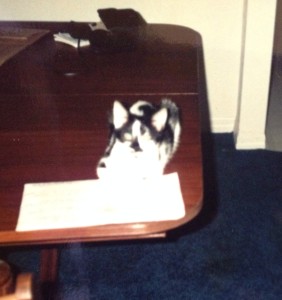 ly shy and timid. I wasn’t particularly interested in her but we made the impulse decision right then and there to get two kittens, thinking they’d be good company for each other when we weren’t home.
ly shy and timid. I wasn’t particularly interested in her but we made the impulse decision right then and there to get two kittens, thinking they’d be good company for each other when we weren’t home.
The one I picked out, Twinkletoes, lived about 6 weeks, dead from feline infectious peritonitis (FIP). We had to put her to sleep and it nearly killed me. The other one—the black and white tuxedo—would live almost 24 years, and entwined herself into our lives and around our hearts in a way I would not have thought possible.
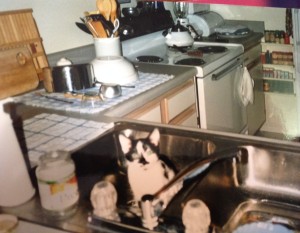 She became “Bunny” in a round-about way. She had a way of sitting that looked as if she’d squeezed herself into a bun, a tight little kitty doorstop, and we jokingly referred to her as the Kitty Bun. That eventually morphed into a host of other nicknames, but she was usually referred to as either Bun Bun or just The Bunny, as in “Where’s the Bunny?”
She became “Bunny” in a round-about way. She had a way of sitting that looked as if she’d squeezed herself into a bun, a tight little kitty doorstop, and we jokingly referred to her as the Kitty Bun. That eventually morphed into a host of other nicknames, but she was usually referred to as either Bun Bun or just The Bunny, as in “Where’s the Bunny?”
Being in grad school with a working wife meant that I spent countless hours at home alone, studying, reading, and writing. The Bunny, meowing, playing, crawling all over me, seeking my attention, sleeping in my lap, was a constant companion. Plus I was the one who fed her, and cats are fast learners. In no time, though I hadn’t chosen her at the pet store, she became my cat. And in essence she became our first child.
 She possessed the sweetest, most gentle disposition I’ve ever known in an animal. When she was home alone, she slept in a prominent place in a basket in a front window in the sunshine. When you came home, she greeted you at the door, was always glad to see you, and couldn’t wait for you to sit down so she could get in your lap. When I wrote at my desk, she laid on the desk. When I read a book or a newspaper, she tried to lay on the book or the newspaper, and most of the time I let her and just did something else. When I watched TV, she stretched out in my lap. If I was home, she was with me or very nearby. She always wanted my attention and she usually got it. I would let her eat food off my plate and even sit on the dining room table. (She loved grilled chicken above all else.) As long as she didn’t actually try to sit on my plate, I was okay with it.
She possessed the sweetest, most gentle disposition I’ve ever known in an animal. When she was home alone, she slept in a prominent place in a basket in a front window in the sunshine. When you came home, she greeted you at the door, was always glad to see you, and couldn’t wait for you to sit down so she could get in your lap. When I wrote at my desk, she laid on the desk. When I read a book or a newspaper, she tried to lay on the book or the newspaper, and most of the time I let her and just did something else. When I watched TV, she stretched out in my lap. If I was home, she was with me or very nearby. She always wanted my attention and she usually got it. I would let her eat food off my plate and even sit on the dining room table. (She loved grilled chicken above all else.) As long as she didn’t actually try to sit on my plate, I was okay with it.
The amount of attention and love I showered upon Bunny was ridiculous. It was for good reason that my friend April once said that she wanted to be reincarnated as my cat. “Spoiled” doesn’t adequately describe it.
Bunny lived through the 8 years that we lived in Gainesville, Florida, through classes, qualifying exams, and the grind and gruel of dissertation research and writing. She then made the move to Savannah with us and took possession of the first house we bought, kindly agreeing to let us live there with her for the next 15 years.
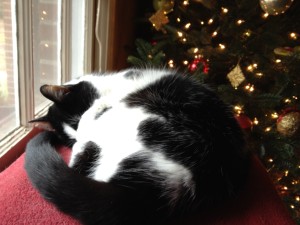 In 2000 she passed the 10-year mark, and as I built my career at the Georgia Historical Society, she took up residence in the customary front window at home, where people could see her every day sleeping on a red blanket. We bought a Persian rug once and when the salesman asked where we lived, he said, “I know that house. You have a black and white cat that sleeps in the window.”
In 2000 she passed the 10-year mark, and as I built my career at the Georgia Historical Society, she took up residence in the customary front window at home, where people could see her every day sleeping on a red blanket. We bought a Persian rug once and when the salesman asked where we lived, he said, “I know that house. You have a black and white cat that sleeps in the window.”
Milestones came and went and Bunny was always there. Every night when I went to bed she found her way to my side and stayed there till morning. When I started getting up 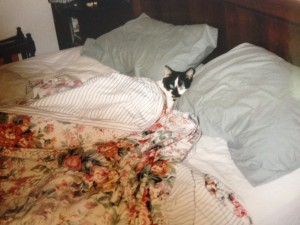 before dawn to read, she got up with me and sat in my lap as I turned the pages, becoming a part of every book I’ve read for the last dozen years. When my family purchased a cabin in the Blue Ridge Mountains in 2003, she went there with us and loved it like a second home. When we visited family in Atlanta for Christmas, she always came with us.
before dawn to read, she got up with me and sat in my lap as I turned the pages, becoming a part of every book I’ve read for the last dozen years. When my family purchased a cabin in the Blue Ridge Mountains in 2003, she went there with us and loved it like a second home. When we visited family in Atlanta for Christmas, she always came with us.
In 200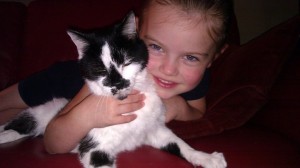 5 she turned 15, still with nary a physical ailment. We had her for almost 16 years before our daughter Ellie was born in 2006, and we thought Bunny wouldn’t be around long enough for Ellie to really ever get to know her. We were wrong of course. After an initial “getting to know you” period, they bonded together too. Bunny turned 20 in 2010 with hardly any sign of slowing down.
5 she turned 15, still with nary a physical ailment. We had her for almost 16 years before our daughter Ellie was born in 2006, and we thought Bunny wouldn’t be around long enough for Ellie to really ever get to know her. We were wrong of course. After an initial “getting to know you” period, they bonded together too. Bunny turned 20 in 2010 with hardly any sign of slowing down.
By that time she had become legendary at the vet. They marveled over how healthy she was, how good she looked, and always raved at her overall condition. With each birthday, she reached uncharted territory.
Aging came slowly, but it eventually came, as it does to all of us. First, her hearing went, which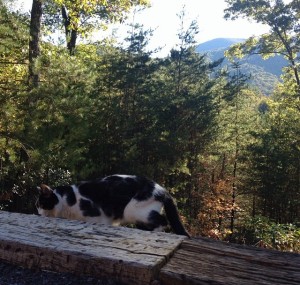 actually made her less jumpy and more mellow—and consequently a better traveler. Her aim, shall we say, at the litter box, got worse and so we had to spread out towels around it. But otherwise she still got around great, still jumped on our bed at night, still had the same loving, sweet personality she’d always had. I began to think she’d just go on forever.
actually made her less jumpy and more mellow—and consequently a better traveler. Her aim, shall we say, at the litter box, got worse and so we had to spread out towels around it. But otherwise she still got around great, still jumped on our bed at night, still had the same loving, sweet personality she’d always had. I began to think she’d just go on forever.
Then in the fall of 2012, at age 22, we noticed one day that her back legs didn’t work exactly as they once had. She had had a stroke. The day before Thanksgiving that fall she began having seizures. Medication could control them but not eliminate the cause, and her doctor said it would be a miracle if she lived another 6 months. She lived those 6 months and kept on going, celebrating her 23rd birthday in July 2013. Walking was difficult, and she seemed confused, but when Christmas arrived, she was there too. It was our 24th Christmas together.
 Her body, finally and inevitably, just gave out, though her indomitable and loving spirit never did. In a matter of a few days, she stopped eating and grew weak, and though we had always hoped she would go on her own, she didn’t. We had to make the painful but necessary decision to have her put to sleep on Tuesday, February 18, 2014, and she died with her head in my hands. In human years she was 114 years old.
Her body, finally and inevitably, just gave out, though her indomitable and loving spirit never did. In a matter of a few days, she stopped eating and grew weak, and though we had always hoped she would go on her own, she didn’t. We had to make the painful but necessary decision to have her put to sleep on Tuesday, February 18, 2014, and she died with her head in my hands. In human years she was 114 years old.
Coming home that day two weeks ago to an empty house, in which we had hardly spent a day without her, was the hardest of all.
Bunny lived a long and unusually healthy life almost up to the end. There is no cause for complaint here; who can ever expect that a 12-week-old kitten that you pick up in a pet store on an autumn Sunday afternoon would live for nearly a quarter of a century? I was 25 when I got her and now stand on the threshold of 50. I know that there will be many more losses to come. Her death marks the end of an era that stretches back almost half of my life, a passing of time and youth and something else that is irreplaceable. I know that there will never be another quite like her.
Many people have said to me how blessed we were to have had such a loving pet for so long,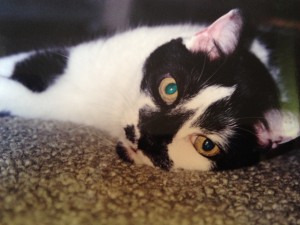 which is of course true. But it’s a blessing and a curse. You want them to live a long time, but after nearly a quarter of a century, they aren’t just your pet anymore. You’ve lived with them every day, woke up to their touch, fed them, nursed them when they grew old. They have been through many sad and happy days with you, been there almost as no one else has, and remained loving and loyal as others came into and went out of your life. They become your friend, your source of love and affection, your companion in ways you could not ever believe when you first get them. They are more a part of your family than some family members are. The loss when they die is real and it is painful, and their passing leaves a void that cannot be filled. As Jean Cocteau wrote, cats become the visible soul of the home.
which is of course true. But it’s a blessing and a curse. You want them to live a long time, but after nearly a quarter of a century, they aren’t just your pet anymore. You’ve lived with them every day, woke up to their touch, fed them, nursed them when they grew old. They have been through many sad and happy days with you, been there almost as no one else has, and remained loving and loyal as others came into and went out of your life. They become your friend, your source of love and affection, your companion in ways you could not ever believe when you first get them. They are more a part of your family than some family members are. The loss when they die is real and it is painful, and their passing leaves a void that cannot be filled. As Jean Cocteau wrote, cats become the visible soul of the home.
Only those who have walked this dark and lonely path themselves understand the depth of grief that comes with losing something so dear. My friend Pamela, who lives in Alaska, has known deep loss herself, and she sent me a note after Bunny’s death. I can do no better than to quote her:
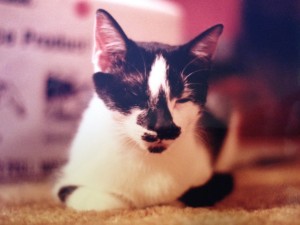 “Losing someone who has been a close companion for 23 years would be indescribably difficult. She clearly was incredibly attached to you to have stayed this long. You did her a kindness, a ‘severe mercy.’ But I personally believe in my heart of hearts that she’s running free right now, beyond age and wear, keeping an eye out for you so that when that time comes, she’ll be there to walk you home too.”
“Losing someone who has been a close companion for 23 years would be indescribably difficult. She clearly was incredibly attached to you to have stayed this long. You did her a kindness, a ‘severe mercy.’ But I personally believe in my heart of hearts that she’s running free right now, beyond age and wear, keeping an eye out for you so that when that time comes, she’ll be there to walk you home too.”

thank you for sharing this information.gmail account login the cat is very cute and nice. It is considered a friend of human. And we can talk with them when we are boring.
Pingback: air max nike
Pingback: fake radar oakleys
Pingback: cheapest oakley sunglasses
Pingback: oakley why 8.2
Pingback: Hermes Lindy bags
Pingback: Lululemon Clothing
Pingback: MK Bags Outlet
Pingback: celine handbags
Pingback: sac lancel
Pingback: ferragamo outlet
Pingback: gucci outlet online
Pingback: prada sneakers
Pingback: Dwana Woodis